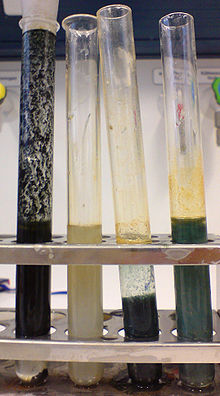Iron(II) hydroxide

| |
| Names | |
|---|---|
| IUPAC name
Iron(II) hydroxide
| |
| Other names
Ferrous hydroxide
| |
| Identifiers | |
3D model (JSmol)
|
|
| ChemSpider | |
| ECHA InfoCard | 100.038.581 |
PubChem CID
|
|
| UNII | |
CompTox Dashboard (EPA)
|
|
| |
| |
| Properties | |
| Fe(OH)2 | |
| Molar mass | 89.86 g/mol |
| Appearance | brown solid |
| Density | 3.4 g/cm3 [1] |
| 0.00015 g/100 mL (20 °C) | |
Solubility product (Ksp)
|
8.0 x 10-16 |
| Hazards | |
| Flash point | Non-flammable |
| Related compounds | |
Except where otherwise noted, data are given for materials in their standard state (at 25 °C [77 °F], 100 kPa).
| |


Iron(II) hydroxide or ferrous hydroxide is a compound produced when iron(II) ions, from a compound such as iron(II) sulfate, react with hydroxide ions. Iron(II) hydroxide itself is practically white, but even traces of oxygen impart it with a greenish tinge. If the solution was not deoxygenated and the iron reduced, the precipitate can vary in color starting from green to reddish brown depending on the iron(III) content. This precipitate is also known as "green rust" in the crystal lattice of which iron(II) ions are easily substituted by iron(III) ions produced by its progressive oxidation. In the presence of oxygen the color changes quickly. Green rust is a powerful reducing agent and also a layer double hydroxide (LDH) capable to sorb anions because of the presence of positive electrical charges borne on its surface. The mineralogical form of green rust is a recently discovered fougerite. All forms of green rust (including fougerite) are more complex and variable than the ideal iron(II) hydroxide compound. The natural analogue of iron(II) hydroxide compound is a very rare mineral amakinite, (Fe,Mg)(OH)2.
Iron(II) hydroxide is poorly soluble (1.43 × 10−3 g/L). It precipitates from the reaction of iron(II) sulfate and hydroxide ions (from a soluble compound containing hydroxide ion):
- FeSO4 + 2 OH− → Fe(OH)2 + SO42−
It is also easily formed as an undesirable by-product of other reactions, a.o., in the synthesis of siderite, an iron carbonate (FeCO3), if the crystal growth conditions are poorly controlled (reagent concentrations, addition rate, addition order, pH, pCO2, T, aging time, ...).
Ageing and transformation into magnetite
Under anaerobic conditions, the iron(II) hydroxide can be oxidized by the protons of water to form iron(II,III) oxide and molecular hydrogen. This process is described by the Schikorr reaction:
- 3 Fe(OH)2 → Fe3O4 + H2 + 2 H2O
The well crystallized iron(II,III) oxide (Fe3O4) is thermodynamically more stable than the iron(II) hydroxide.
Uses
Anions such as selenite and selenate can be easily adsorbed on the positively charged surface of iron(II) hydroxide where they are subsequently reduced by Fe2+. The resulting products are poorly soluble (Se0, FeSe, or FeSe2).
Iron(II) hydroxide has also been investigated as an agent for the removal of toxic selenate and selenite ions from water systems such as wetlands. The iron(II) hydroxide reduces these ions to elemental selenium, which is insoluble in water and precipitates out.[2]
Note: pKsp = 15.097 where p is the -log and Ksp is the Solubility Product Constant. This means it has a low tendency to dissolve, but is not entirely insoluble. An acidic solution would allow this to disassociate more because the H+ would react with the OH- in the compound.
In a basic solution iron(II) hydroxide is the electrochemically active material of the negative electrode of the nickel-iron battery.
See also
References
- ^ Pradyot Patnaik. Handbook of Inorganic Chemicals. McGraw-Hill, 2002, ISBN 0070494398
- ^ Zingaro, Ralph A. (1997). "Reduction of oxoselenium anions by iron(II) hydroxide". Environment International. 23 (3): 299–304. doi:10.1016/S0160-4120(97)00032-9.
{{cite journal}}: Unknown parameter|coauthors=ignored (|author=suggested) (help)
